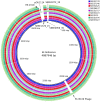On the evolutionary history, population genetics and diversity among isolates of Salmonella Enteritidis PFGE pattern JEGX01.0004
- PMID: 23383127
- PMCID: PMC3559427
- DOI: 10.1371/journal.pone.0055254
On the evolutionary history, population genetics and diversity among isolates of Salmonella Enteritidis PFGE pattern JEGX01.0004
Abstract
Facile laboratory tools are needed to augment identification in contamination events to trace the contamination back to the source (traceback) of Salmonella enterica subsp. enterica serovar Enteritidis (S. Enteritidis). Understanding the evolution and diversity within and among outbreak strains is the first step towards this goal. To this end, we collected 106 new S. Enteriditis isolates within S. Enteriditis Pulsed-Field Gel Electrophoresis (PFGE) pattern JEGX01.0004 and close relatives, and determined their genome sequences. Sources for these isolates spanned food, clinical and environmental farm sources collected during the 2010 S. Enteritidis shell egg outbreak in the United States along with closely related serovars, S. Dublin, S. Gallinarum biovar Pullorum and S. Gallinarum. Despite the highly homogeneous structure of this population, S. Enteritidis isolates examined in this study revealed thousands of SNP differences and numerous variable genes (n = 366). Twenty-one of these genes from the lineages leading to outbreak-associated samples had nonsynonymous (causing amino acid changes) changes and five genes are putatively involved in known Salmonella virulence pathways. While chromosome synteny and genome organization appeared to be stable among these isolates, genome size differences were observed due to variation in the presence or absence of several phages and plasmids, including phage RE-2010, phage P125109, plasmid pSEEE3072_19 (similar to pSENV), plasmid pOU1114 and two newly observed mobile plasmid elements pSEEE1729_15 and pSEEE0956_35. These differences produced modifications to the assembled bases for these draft genomes in the size range of approximately 4.6 to 4.8 mbp, with S. Dublin being larger (∼4.9 mbp) and S. Gallinarum smaller (4.55 mbp) when compared to S. Enteritidis. Finally, we identified variable S. Enteritidis genes associated with virulence pathways that may be useful markers for the development of rapid surveillance and typing methods, potentially aiding in traceback efforts during future outbreaks involving S. Enteritidis PFGE pattern JEGX01.0004.
Conflict of interest statement
Figures



References
-
- Stanley J, Goldsworthy M, Threlfall EJ (1992) Molecular phylogenetic typing of pandemic isolates of Salmonella enteritidis. FEMS Microbiol Lett 69: 153–160. - PubMed
-
- Saeed AM, Walk ST, Arshad M, Whittam TS (2006) Clonal structure and variation in virulence of Salmonella Enteritidis isolated from mice, chickens, and humans. J AOAC Int 89: 504–511. - PubMed
-
- Botteldoorn N, Van Coillie E, Goris J, Werbrouck H, Piessens V, et al. (2010) Limited genetic diversity and gene expression differences between egg- and non-egg-related Salmonella Enteritidis strains. Zoonoses Public Health 57 (5) 345–57. - PubMed
-
- Liu F, Kariyawasam S, Jayarao BM, Barrangou R, Gerner-Smidt P, et al. (2011) Subtyping Salmonella enterica serovar enteritidis isolates from different sources by using sequence typing based on virulence genes and clustered regularly interspaced short palindromic repeats (CRISPRs). Appl Environ Microbiol 77 (13) 4520–6. - PMC - PubMed
Publication types
MeSH terms
LinkOut - more resources
Full Text Sources
Other Literature Sources
Molecular Biology Databases
Miscellaneous

